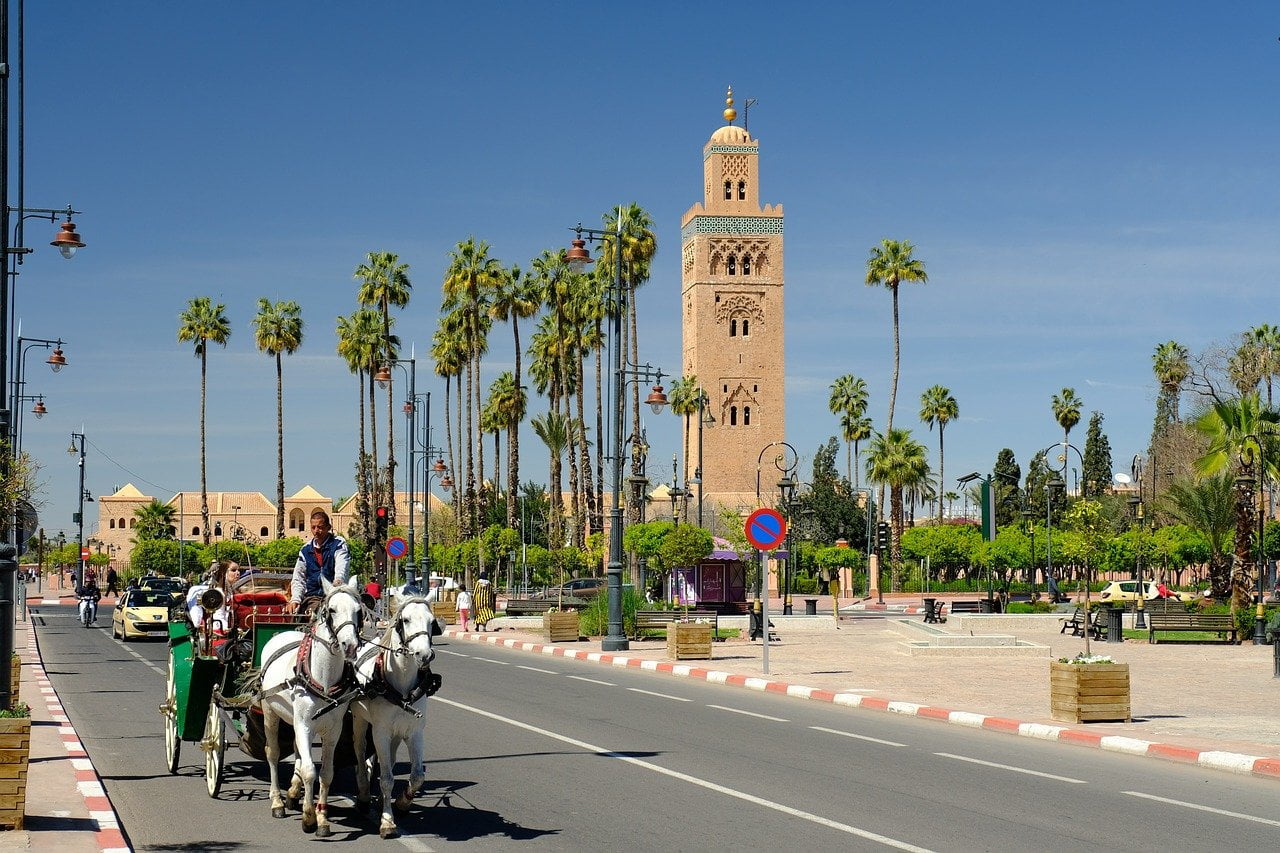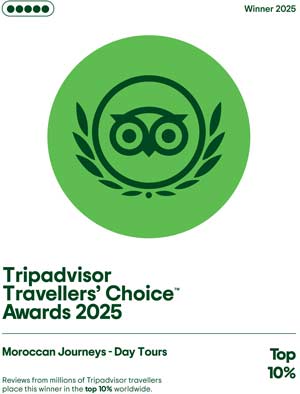Home » Discover Comprehensive Moroccan Travel Advice & Local Tips » Sahara Desert Facts & How to Visit Morocco’s Dunes

The Sahara is the world’s largest hot desert, stretching across North Africa. Morocco sits on its north-western edge, where golden dunes meet palm groves, historic caravan towns and starry skies.
This guide focuses on the Moroccan Sahara – practical facts, climate, how to get there, what to pack, and how to choose between the famous dune fields of Erg Chebbi (near Merzouga) and Erg Chigaga (near M’Hamid).
If you prefer everything arranged, our
Sahara Desert Tours in Morocco
cover comfortable camps and expert drivers.
Table of Contents
- Quick facts
- Where the Moroccan Sahara fits in
- Landscape at a glance
- Climate & best time to visit
- Getting there: distances & travel times
- Erg Chebbi vs Erg Chigaga
- Culture, nature & oases
- Was the Sahara always this dry?
- Responsible travel tips
- What to pack
- Suggested routes & related trips
- Photography & star-gazing tips
- About the author
Quick facts
A concise reference to help you place the Sahara and understand how Morocco fits within it.
| Total area of the Sahara | About 9.2 million km² (≈ 3.6 million sq miles). It is the largest hot desert; only Antarctica and the Arctic are larger as deserts overall. |
|---|---|
| Boundaries | Atlantic (west), Atlas Mountains & Mediterranean (north), Red Sea (east), Sahel (south). |
| Countries spanned | Morocco, Western Sahara, Algeria, Tunisia, Libya, Egypt, Mauritania, Mali, Niger, Chad, Sudan. |
| People | Several million across the whole region, concentrated around oases, valleys and towns. |
| Surface types | Only about a fifth is sand sea (erg). Most of the Sahara is gravel plain (reg) or rocky plateau (hamada). |
Where the Moroccan Sahara fits in

Beyond the High Atlas and Anti-Atlas ranges you reach two accessible sand seas:
- Erg Chebbi – beside Merzouga; classic orange dunes rising up to around 150 metres; a wide choice of camps and activities. See our
Marrakech → Merzouga Tour and
Fes → Merzouga Desert Tour. - Erg Chigaga – reached by 4×4 from M’Hamid; wilder and less developed with broad rolling dunes. Explore our
Erg Chigaga Luxury Desert Camp, including
Location & Transport,
Activities & Trekking and
Tent Suites & Rates.
Landscape at a glance: ergs, regs, hamadas & oases
- Erg: a sand sea of dunes (Erg Chebbi, Erg Chigaga).
- Reg: vast gravel plains – open, stony and dramatic.
- Hamada: barren rock plateaus and outcrops.
- Oases: fertile pockets fed by groundwater, such as the Tafilalt around Erfoud/Rissani and the palm-lined Drâa Valley (featured on our
Kasbahs & Gorges route).
Climate & best time to visit
Expect hot days and cool nights for much of the year. Mid-summer can be extreme in the dunes, while winter nights (Dec–Feb) can dip close to freezing in the open desert.
| Season | Typical daytime | Typical night-time | What it’s like |
|---|---|---|---|
| Oct–Nov | Mid-20s to low-30s °C | Low-teens °C | Comfortable days, clear skies; superb light for photography. |
| Dec–Feb | High-teens to low-20s °C | 0–6 °C | Cold nights; bring thermals for camp stays. |
| Mar–May | Low-20s → low-30s °C | Single digits → teens | Warm and bright; occasional breezy spells. |
| Jun–Aug | High-30s to 40+ °C | Low- to mid-20s °C | Plan sunrise/sunset dune time and long shaded breaks; air-conditioned transfers help. |
| Sep | Low- to mid-30s °C | High-teens to low-20s °C | Usually dry; the odd late-summer storm is possible. |
Luxury Marrakech & Sahara Tour
works particularly well in these months.
Getting there: distances & travel times
These are typical overland distances and drive times used in itinerary planning. Your time will vary with stops and road conditions.
| Route | Approx. distance | Typical drive time | Notes |
|---|---|---|---|
| Marrakech → Merzouga (Erg Chebbi) | ≈ 550–560 km | ≈ 8–10 hours | Across the High Atlas via Tizi n’Tichka, Ouarzazate and the Todra/Ziz valleys. Consider a stop at Aït Ben Haddou. |
| Fes → Merzouga (Erg Chebbi) | ≈ 460–470 km | ≈ 7–8 hours | Via Midelt and the Ziz Valley; see our Fes → Merzouga itinerary. |
| Marrakech → M’Hamid (Erg Chigaga access) | ≈ 446–460 km | ≈ 8–9 hours | Via Ouarzazate and the Drâa Valley; final approach by 4×4 to the dunes and Erg Chigaga Luxury Desert Camp. |
If time is tight, consider a one-way circuit to reduce backtracking, or add a night in the valleys. We plan transfers, comfort stops and scenic pauses to suit your pace.
Erg Chebbi vs Erg Chigaga: which suits your trip?
Both areas are outstanding. Use this comparison to decide which fits your time and travel style.
| Feature | Erg Chebbi (Merzouga) | Erg Chigaga (M’Hamid) |
|---|---|---|
| Dune character | Taller dunes with striking ridgelines; easy access from Merzouga. | Broader dune fields with a wilder feel and fewer visitors. |
| Access | Good roads; short track to camps. | 4×4 off-road approach with experienced drivers. |
| Time needed | Works well as a 3-day return from Marrakech or Fes. | Best on a 4–5 day circuit through the Drâa Valley to Erg Chigaga Luxury Camp. |
| Camp style | Comfort and premium options; see the Luxury Desert Tour. | Private set-ups available: Private Camp and Tent Suites & Rates. |
| Activities | Camel rides, sandboarding and gentle dune walks: Merzouga Camel & Horse Trek. | Longer treks and quiet star-watching: Erg Chigaga Activities & Trekking and Dining Under the Stars. |
Culture, nature & the living desert

- People & heritage: Amazigh (Berber) communities, Gnawa music, markets in Rissani and centuries of caravan trade. Our
Cultural Tour blends desert time with classic sites. - Oases & valleys: the Drâa Valley south of Zagora is a ribbon of palms and mud-brick villages — featured on the
Merzouga & Zagora Tour. - Wildlife: look for fennec fox tracks, desert larks and hoopoes; camel caravans remain a familiar sight around camps.
Was the Sahara always this dry?
No. During the African Humid Period (roughly 11,000–5,000 years ago), much of the Sahara held lakes, rivers and grassland. The present climate is the result of long-term natural shifts. Former shorelines and ancient rock art still mark parts of the desert.
Responsible travel in the desert
- Heat & hydration: carry 2–3 litres of water per person for daytime excursions; cover up with light, long sleeves; use high-SPF sun cream and a wide-brim hat.
- Cold nights: in winter pack thermals, warm socks and a beanie; camps provide bedding but your own layers help.
- Wind & sand: a scarf and small goggles are handy between December and May when breezes can pick up.
- Tracks & dunes: keep to established routes; take all litter out; choose operators with good camel care.
What to pack
- Light long-sleeve shirts and trousers; a warm layer for nights (fleece or light down), especially Dec–Feb.
- Closed shoes for camp, sandals for tents; optional socks for hot sand.
- Sun hat, scarf, sunglasses, SPF 30+ sun cream, lip balm.
- Reusable water bottles and electrolyte sachets.
- Head torch, small daypack, power bank.
- Personal medication and a simple first-aid kit.
Suggested routes & related trips
Popular ways to shape a desert journey, with links to detailed pages:
- 3 days Marrakech → Merzouga (Erg Chebbi) – the most time-efficient path to tall dunes, with valleys and gorges en route.
- 3 days Fes → Merzouga – mountain and Ziz Valley scenery, a cooler approach in summer.
- Luxury Marrakech & Sahara Tour – riads, private 4×4 transfers and a premium desert camp.
- Erg Chigaga Luxury Desert Camp – remote dunes, campfire nights and dark skies; consider a
private event or group stay. - Atlas & Sahara Walking Tour – guided hikes in the High Atlas followed by soft-sand trekking.
- Sahara Walking Holiday – multi-day desert walks with light support and starry camp nights.
- Travelling from Marrakech? Add a day to see the High Atlas and UNESCO-listed ksar on our
Aït Ben Haddou day trip, or break the journey with a valley walk on the
Atlas Mountains day trip.
Enquire now or browse
Morocco travel information and practical
FAQs.
Photography & star-gazing tips

- Best dune light is within an hour of sunrise and sunset; mid-day is harsh and better for rest.
- Carry a lens cloth and keep gear sealed from blowing sand.
- For the night sky, a small tripod and a head torch with red mode are helpful.
- At Erg Chigaga, consider a quiet dinner under the sky:
Dining Under the Stars.
About the author
Written by Rebecca Hutley. Last updated: 28 August 2025.
Frequently Asked Questions
The name “Sahara desert” originated from the Arab conquerors of North Africa in the 7th century AD, who referred to it as “al-sahara,” meaning “the desert.”
The depth of sand in the Sahara desert varies across locations and seasons, making it difficult to provide a definitive answer. On average, the depth is estimated to be around 16 feet (5 meters).
Within the Sahara desert, notable sand dunes called ergs can be found. The tallest erg, Erg Chebbi, rises to a height of 150 meters (490 feet).
The past existence of green areas in the Sahara desert remains uncertain, although some research suggests it is a possibility. The Sahara, situated in the tropics, experiences year-round summer weather. However, due to its vast size, the climate varies across different regions.
In the northern Sahara, summer temperatures can soar up to 50 degrees Celsius (122 degrees Fahrenheit), creating inhospitable conditions for plant growth. Conversely, the southern Sahara can experience winter temperatures dropping below freezing point. These variations imply the potential existence of green areas in the past.
The Sahara desert, formed by the merging of the Gaetulian and Libya Deserts, is estimated to be around 4.6 million years old. Covering an expansive area of over 3 million square miles, it ranks among the largest and hottest deserts globally. With average temperatures surpassing 100 degrees Fahrenheit, the Sahara experiences extreme weather phenomena like dust storms, sandstorms, and flash floods.
- The Sahara desert is the largest hot desert in the world, and the third largest desert overall, after the Antarctic and Artic Polar deserts.
- The Sahara desert is home to some of the harshest weather conditions on earth, with temperatures that can reach up to 125 degrees Fahrenheit (51 degrees Celsius) during the day.
- Despite its hostile environment, the Sahara desert is home to a wide variety of animal life. One of the most famous creatures that call the Sahara home is the camel and African Lions can also be found in the south Sahara desert
- It’s also home to some amazing plants, like cacti and date palms.
- The Sahara desert has a long and storied history and has been inhabited by humans for centuries. Some of the most famous civilizations to have emerged from the Sahara include Ancient Egypt and Carthage.















